Ticks in Florida are year-round due to its warm, humid climate. They’re found in backyards, woods, and even coastal areas. To get rid of them, wear protective clothing, check for ticks after outdoor activity, and use professional pest control like Hoffer Pest Solutions for long-term prevention.
![]()
Although Florida isn't known as a Lyme disease hotspot, tick populations here are active year-round and carry a range of illnesses from red meat allergies to spotted fevers. They lurk in surprising places, from manicured lawns to pet bedding, posing risks for families, pets, and outdoor enthusiasts alike.
Whether you’re trying to protect your kids from bites, worried about your dog dragging ticks indoors, or wondering if ticks are worse after storms, this guide breaks it all down. You’ll learn:
When ticks are most active in Florida
What species live here and the diseases they spread
Where ticks hide in homes, yards, and yes, even beaches
What steps you can take to prevent bites without harsh chemicals
How Hoffer Pest Solutions can help eliminate them for good
If you’re just here for the facts and solutions, we’ve got you covered. But if you want the full breakdown, including tips, lesser-known insights, and action steps, keep reading.
The Truth About Florida’s Tick Population
Florida’s lush environment and wildlife diversity create the perfect storm for tick survival and reproduction. What makes this even more challenging is that:
Florida is home to five or more active tick species, each with its own disease risks and behavior patterns.
While suburban and urban areas may seem safer, ticks can still thrive in small patches of shade, mulch beds, or overwatered lawns.
And unlike in northern states where freezing winters slow tick activity, Florida’s warmth and humidity mean ticks stay active all year long, just at different life stages.
This makes it critical for Florida residents to be aware of which types they might encounter and what symptoms to watch for.
The Most Common Tick Species in Florida
Blacklegged (Deer) Ticks
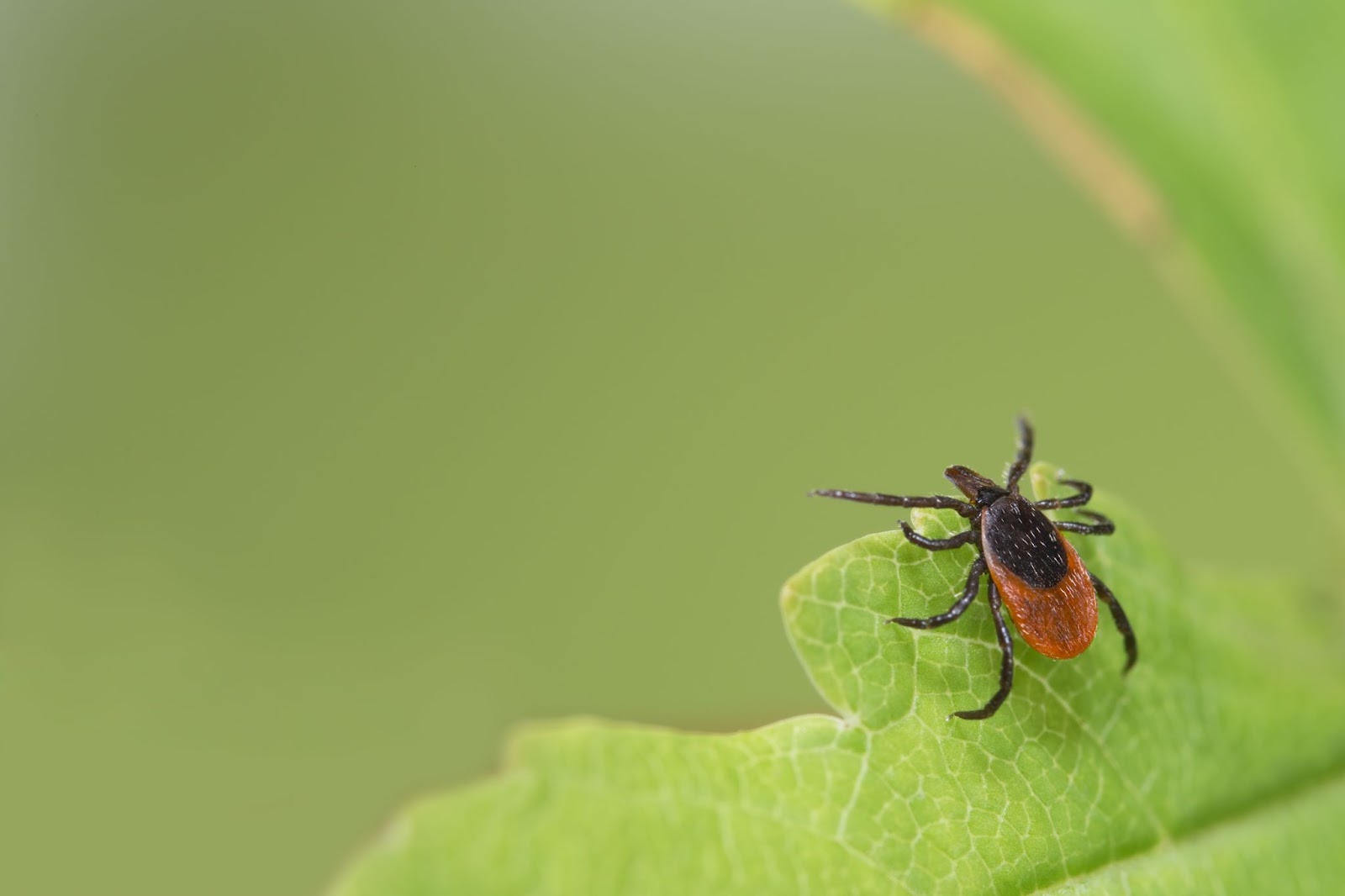
![]()
Known for spreading Lyme disease, babesiosis, and human granulocytic anaplasmosis (HGA), these ticks are most commonly found in deciduous forests and shaded, grassy areas. Their nymph stage, which peaks in spring and summer, is the most dangerous due to its small size and increased likelihood of going undetected.
Lone Star Ticks
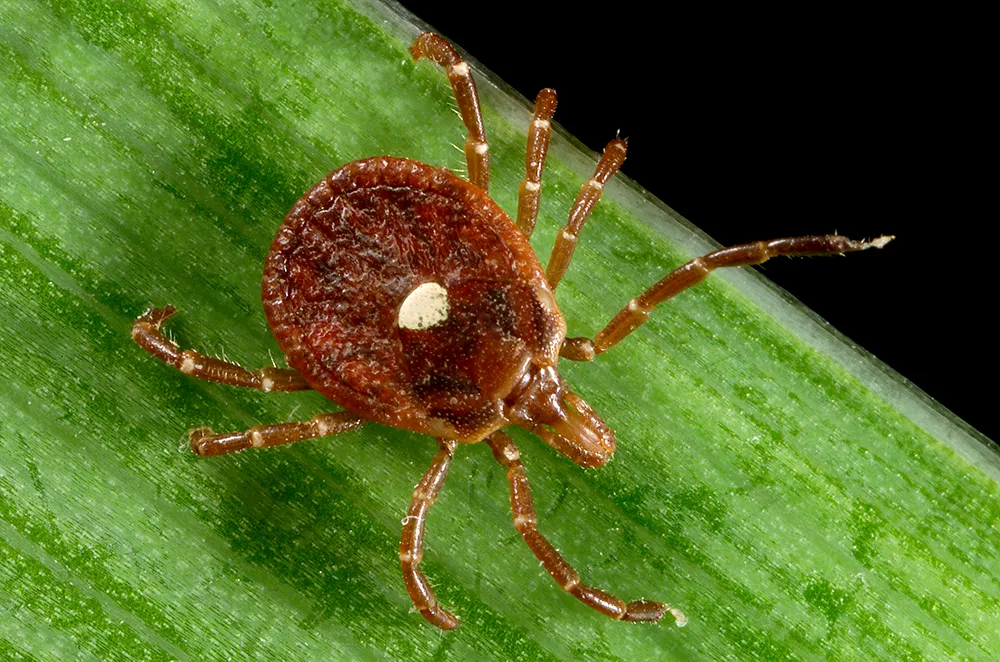
![]()
Florida’s most aggressive biter, the lone star tick, targets humans more frequently than other species. While it can carry ehrlichiosis, STARI, and Rocky Mountain spotted fever, its most notorious effect is alpha-gal syndrome, a serious allergy to red meat. This syndrome, triggered by a sugar molecule in the tick’s saliva, has raised alarm among hunters and outdoorsmen throughout the South.
Do ticks live near the beach or only in the woods?
Yes, ticks can be found in coastal dunes, marshy paths, and overgrown beach access points. You don’t have to be deep in the forest to get bitten.
American Dog Ticks
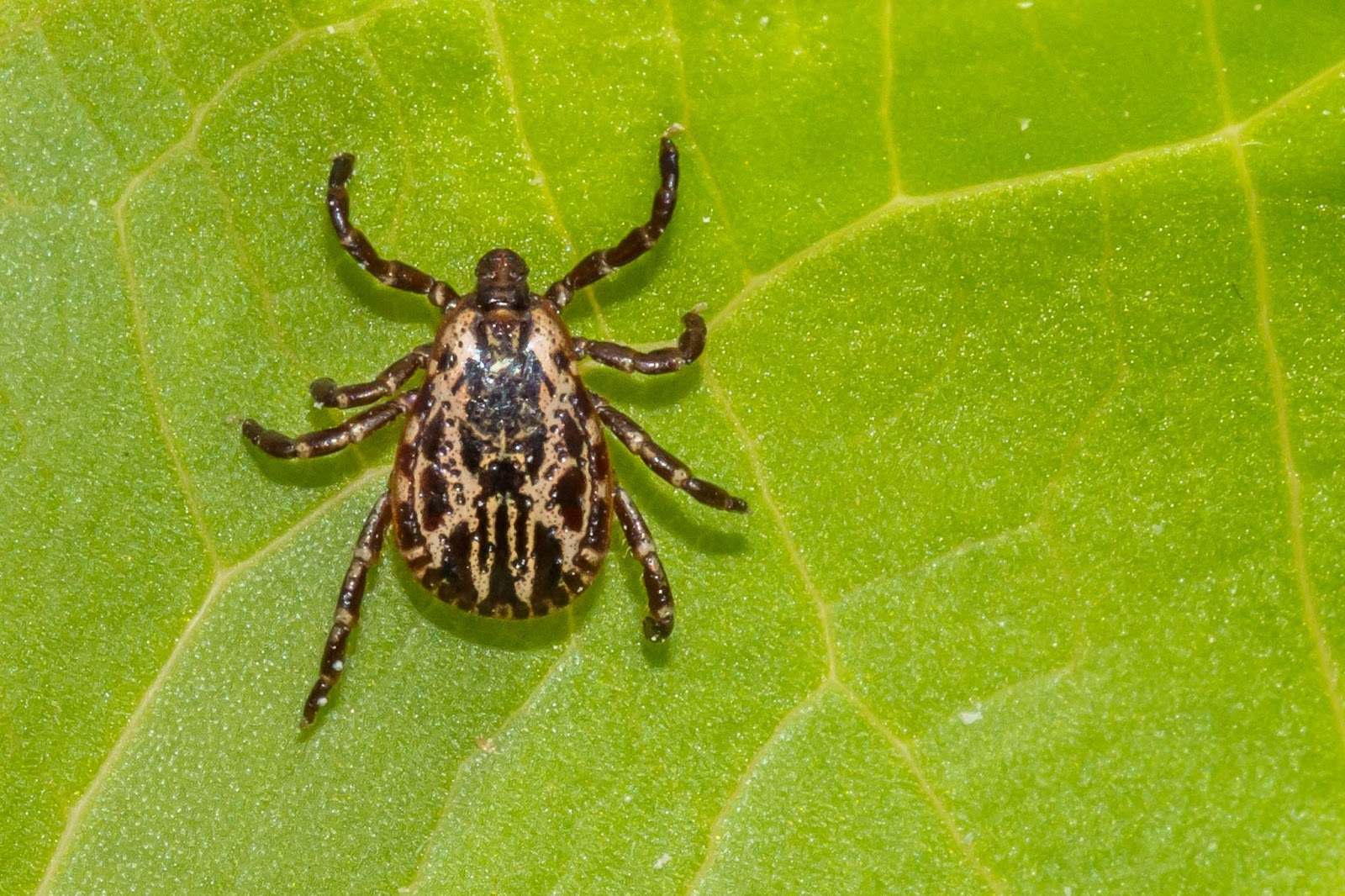
![]()
Thriving in grassy fields and open habitats, this tick prefers medium-sized mammals like dogs, raccoons, and skunks. It is a known vector for Rocky Mountain spotted fever, though not forLyme disease.
Brown Dog Ticks
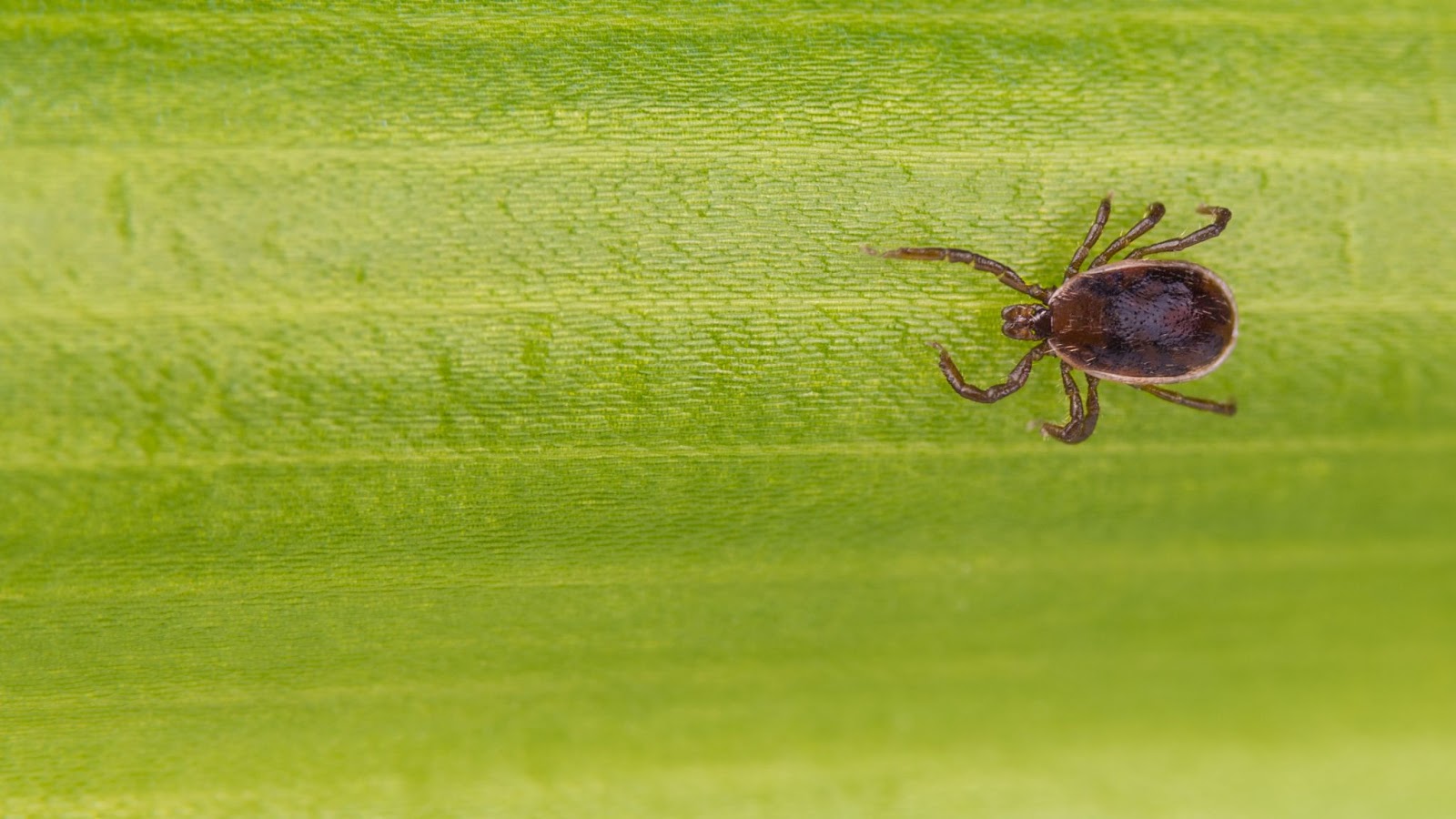
![]()
This species stands out because of its ability to infest homes, kennels, and indoor spaces. Once inside, brown dog ticks are incredibly difficult to eliminate and pose a serious risk to pets, often requiring professional pest control for full removal.
Gulf Coast Ticks
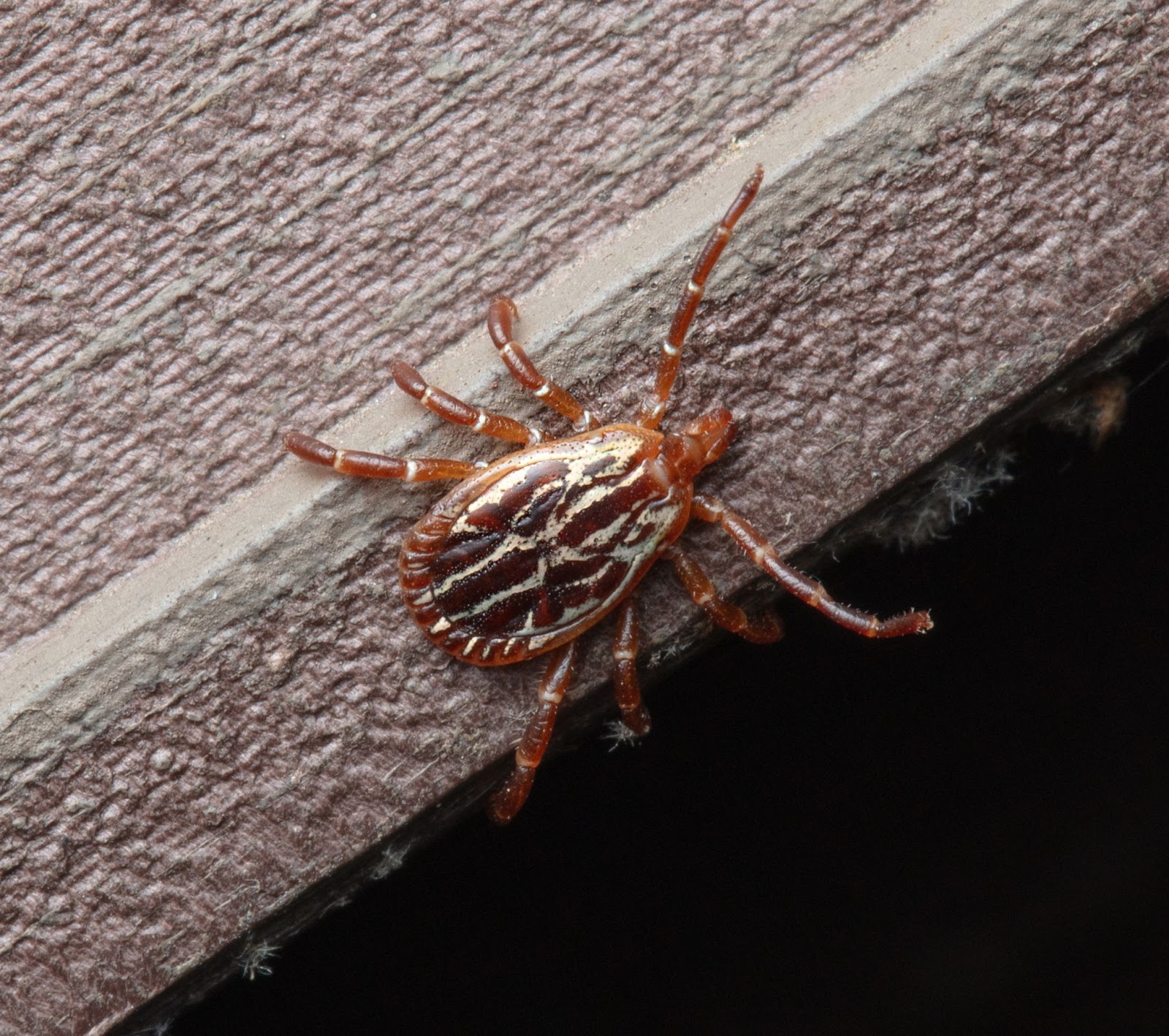
![]()
Common along the Atlantic and Gulf Coast, this tick can transmit Rickettsia parkeri, which causes a spotted fever that mimics the symptoms of RMSF. These ticks are active in humid, coastal brush areas, a concern for those living near the water or maintaining waterfront properties.
When Are Ticks Most Active in Florida?
In most states, ticks have a clear season, but not in Florida. Thanks to our mild winters and high humidity, tick activity persists all year long. However, there are seasonal patterns tied to the life stages of different species.
Spring and early summer (April–June) see a spike in nymph-stage ticks, which are harder to spot and more likely to transmit disease.
Fall (September–November) marks another peak, especially for adult blacklegged ticks that are active through late spring.
Adult ticks, particularly deer ticks, tend to be active from September to May, meaning that even winter outdoor activity comes with risk.
Florida’s unpredictable weather can also affect tick behavior. Hurricanes and heavy rains leave behind moisture and organic debris, creating ideal breeding grounds for ticks. After a storm, tick populations often surge in both public parks and private yards.
Where Do Ticks Live in Florida?
While many assume ticks only thrive deep in the woods, the reality in Florida is far more concerning. Ticks are habitat opportunists, and in our warm, moisture-rich environment, they can live in places you’d never expect.
![]()
High-Risk Tick Environments in Florida Include:
Tall grass and overgrown vegetation
Shrubs and ornamental ground covers, especially those bordering fences and walkways
Leaf litter, mulch beds, and underbrush
Pet bedding, outdoor kennels, and frequented dog parks
Shaded pool areas and landscaping features that hold moisture
Florida’s lush landscaping choices, especially in suburban neighborhoods, can inadvertently create perfect tick breeding zones, even on well-maintained properties. Ticks don't need thick woods to thrive. Even a single untrimmed corner of your yard can host hundreds of larvae or nymphs.
Brown Dog Ticks: Florida’s Indoor Threat
Unlike other species, brown dog ticks can live entirely indoors. They hide in:
Carpet fibers
Behind baseboards
Inside couch cushions and pet beds
Their ability to complete their entire lifecycle inside homes makes them especially difficult to eliminate without professional help.
Can ticks get through patio mesh?
Yes. Small nymph-stage ticks can easily squeeze through standard patio screens. They may be barely visible to the naked eye, but they can still latch on and feed if given the opportunity.
What Diseases Do Florida Ticks Carry?
Florida may not have the same Lyme disease numbers as the Northeast, but that doesn’t mean its ticks are harmless. In fact, ticks in the South carry a more diverse and misunderstood set of pathogens, and symptoms can often mimic other common illnesses, leading to misdiagnosis or delayed treatment.
Lyme Disease, Should You Worry?
Lyme disease does exist in Florida, but it is rare compared to northern states. The CDC reports around 40 confirmed cases per year, but that number may be underreported due to misidentification or lack of awareness.
Nymph-stage blacklegged ticks are the main transmitters and are most active in spring and early summer.
Because they’re so small, many bites go unnoticed until symptoms, like fatigue, joint pain, or rash, set in days later.
Counties with higher deer populations tend to have more risk, as deer are a major host.
Other Tick-Borne Illnesses in Florida
While Lyme gets the most attention, other diseases are more prevalent in Florida and can be just as serious if untreated.
Alpha-Gal Syndrome
Caused by the bite of a lone star tick
Triggers a delayed allergic reaction to red meat
Symptoms include hives, stomach cramps, and even anaphylaxis hours after eating beef, pork, or lamb
This non-traditional illness is on the rise in the South and often goes undiagnosed because most people don’t associate meat allergies with tick bites.
Spotted Fevers
Spread by Gulf Coast and American dog ticks
Includes Rocky Mountain spotted fever and Rickettsia parkeri rickettsiosis
Symptoms include rash, high fever, muscle aches, and headache
Ehrlichiosis and STARI (Southern Tick-Associated Rash Illness)
Cause flu-like symptoms such as chills, fatigue, and nausea
Often misdiagnosed as mild viral infections
STARI presents with a bullseye rash similar to Lyme, but doesn’t cause long-term complications
How to Avoid Ticks in Florida
Staying tick-free in Florida doesn’t mean avoiding the outdoors altogether, it means being smart about prevention. With the right habits, clothing, and quick checks, you can reduce the risk of a bite dramatically, even in high-risk areas like wooded parks, leaf piles, or shaded yards.
Personal Protection While Outdoors
Florida’s tick population is aggressive, but that doesn’t mean you're defenseless. Whether you're gardening, hiking, or just walking the dog, following these steps can help protect you and your family:
Wear light-colored, long-sleeved clothing so ticks are easier to spot before they latch on.
Tuck pants into your socks or boots to prevent ticks from crawling up your legs.
Apply EPA-approved repellents like DEET or permethrin to exposed skin and clothing.
When hiking or exploring wooded areas, stick to the center of the trail and avoid brushing against tall grass or shrubs.
These small changes can go a long way in reducing exposure, especially in Florida, where tick season never truly ends.
Full-Body Tick Checks After Outdoor Activity
Even with protective measures, tick checks are a must. Most tick-borne diseases require the tick to remain attached for 12–48 hours to transmit pathogens, so early removal can prevent infection entirely.
Key areas to check after any outdoor activity:
Behind the ears
Scalp and hairline
Groin area
Waistband and behind the knees
Armpits
Be especially diligent with children, as they tend to play low to the ground and in areas where ticks wait to attach.
Are Ticks a Problem for Pets in Florida?
Absolutely, and more so than many pet owners realize. Florida's pet-friendly climate means dogs and outdoor cats are at constant risk, especially if they roam through shaded lawns, underbrush, or community parks.
Ticks don’t just bite, they hitch a ride indoors on your pets and can establish full infestations in carpets, furniture, and bedding. Brown dog ticks, in particular, are notorious for setting up camp inside homes and reproducing in large numbers without anyone noticing until it’s too late.
How to Protect Your Pets:
Keep pets on veterinarian-recommended tick preventatives such as Simparica Trio, Bravecto, or Seresto collars.
Regularly inspect their ears, paws, neck folds, and belly, ticks often hide in fur-covered areas.
Wash and heat-dry pet bedding weekly.
Consider professional pest control if you suspect ticks are coming in through pets.
What Should You Do If You Find a Tick?
If you discover a tick on yourself, your child, or your pet. Don't panic, but act quickly. The method of removal can make a huge difference in whether disease is transmitted.
How to Remove a Tick Properly
Use fine-tipped tweezers to grasp the tick as close to the skin’s surface as possible.
Pull upward with steady, even pressure. Avoid twisting or jerking.
Disinfect the bite site with rubbing alcohol, antiseptic, or soap and water.
Save the tick in a sealed container or bag in case you develop symptoms later, it may help your doctor identify the pathogen.
When to Seek Medical Attention
Not all tick bites lead to illness, but if you develop symptoms in the days or weeks following a bite, so act quickly. Seek medical care if you experience:
Rash (especially a bullseye-shaped rash)
Fatigue
Fever or chills
Muscle aches or joint pain
Headache or nausea
Pro Tip: Take a photo of the bite and save the tick, if possible. Some tick-borne diseases have delayed symptoms, and identification can guide faster, more accurate treatment.
Florida-Specific Tick Control for Homes and Yards
Even the most cautious homeowners can find themselves dealing with ticks. Florida's year-round warmth, humidity, and dense vegetation make it a perfect breeding ground. While DIY solutions can help reduce exposure temporarily, they often fall short of eliminating the problem entirely.
Why DIY Tick Control Often Fails
Homeowners commonly turn to over-the-counter sprays or essential oils, but ticks are more resilient than most pests, especially in Florida’s unique climate.
Here’s why store-bought solutions often don’t cut it:
Ticks can survive washing machines, making laundry ineffective after outdoor exposure.
They hide in mulch beds, beneath decks, and in dog kennels, where sprays don’t reach.
Improper identification leads to mistargeted treatments; each tick species responds differently to control methods.
Without professional-grade tools, it’s nearly impossible to stop ticks at every stage of their lifecycle, from larvae to adult, especially when infestations are happening indoors and out.
Year-Round Tick Control Plans That Work
![]()
We’ve spent over 40 years studying how pests behave in Florida’s climate. Our tick control plans are designed specifically for South Florida homes, using a combination of proactive treatments, knowledge, and family-safe solutions.
We offer:
Monthly and quarterly perimeter treatments to create invisible barriers around your home
Granular and liquid lawn applications that target breeding zones like mulch, leaf piles, and shaded turf
Bundled mosquito, flea, and tick prevention plans, so you don’t have to juggle multiple services
Protection from over 20 common Florida pests, including spiders, roaches, ants, and rodents
Our Home Shield Complete Plan includes tick, mosquito, flea, termite, and rodent protection, all in one easy, reliable package. It’s a one-stop solution for year-round peace of mind.
Why Florida Homeowners Trust Hoffer Pest Solutions
![]()
A Family-Owned Company That Lives Here Too
We’re not just a pest control company, we’re your neighbors. Hoffer Pest Solutions has been protecting Florida homes and families for over four decades. Our technicians are locals who understand the seasonal shifts, regional pest patterns, and environmental factors that make Florida pest control different.
Over 40 years serving South Florida
A team that knows exactly how ticks behave and spread here
Same-day service available if you call before noon
We believe pest control is a responsibility. One we take seriously every time we knock on a door.
Testimonials & Community Trust
We’re proud to support the same communities we serve, through charity events, local partnerships, and employee-led initiatives. When one of our team members supports a cause, we show up. From breast cancer walks to Habitat for Humanity builds, our company is built on relationships, not just results.
Stay Tick-Free in Florida
Florida’s beautiful climate comes with hidden challenges, ticks being one of the most persistent. But with the right knowledge, preventive habits, and professional support, you can take control of your property and protect your family, pets, and peace of mind.
Hoffer Pest Solutions is here to help, because no one should have to choose between enjoying the outdoors and staying safe from pests. We live here too, and we know what it takes to fight Florida’s toughest infestations.
Call Hoffer Pest Solutions today and ask about our Home Shield Plans for total protection, inside and out.
Frequently Asked Questions
Are ticks worse after hurricanes or heavy rains in Florida?
Yes. After major storms or hurricanes, moisture and organic debris create ideal conditions for ticks to reproduce. Overgrown grass, fallen branches, and leaf piles offer shelter and humidity, often causing a surge in tick activity just when homeowners are outdoors cleaning up.
Can indoor plants attract ticks in humid homes?
While ticks don’t feed on plants, they may use potted plants as temporary shelter, especially in humid, shaded areas near pet resting zones or entryways. If ticks are already inside (often from pets), they may hide in plant soil or containers between blood meals.
What’s the best natural way to keep ticks off my kids without harsh chemicals?
Planting tick-repelling plants like mint, marigolds, or lemongrass can reduce tick presence around play areas. You can also use natural sprays with cedarwood or citronella, although Florida’s humidity can reduce their effectiveness. For high-risk areas, professional-grade treatments are more reliable.
Are there natural predators of ticks I can encourage in my yard?
Yes. Beneficial nematodes, certain species of birds like guineafowl, and even opossums are known to eat ticks. However, relying solely on predators won't provide full protection. They can help as part of an integrated pest management plan.
Is there a map of Florida tick hotspots by county?
While there’s no real-time public map, data from the Florida Department of Health and CDC show that central and northern counties, especially those with high deer populations, report more cases of tick-borne illnesses. Still, ticks are active statewide, including in South Florida's residential zones.


